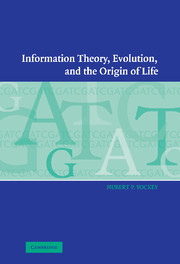Book contents
- Frontmatter
- Contents
- Preface
- 1 The genetic information system
- 2 James Watson, Francis Crick, George Gamow, and the genetic code
- 3 The Central Dogma of molecular biology
- 4 The measure of the information content in the genetic message
- 5 Communication of information from the genome to the proteome
- 6 The information content or complexity of protein families
- 7 Evolution of the genetic code and its modern characteristics
- 8 Haeckel's Urschleim and the role of the Central Dogma in the origin of life
- 9 Philosophical approaches to the origin of life
- 10 The error catastrophe and the hypercycles of Eigen and Schuster
- 11 Randomness, complexity, the unknowable, and the impossible
- 12 Does evolution need an intelligent designer?
- 13 Epilogue
- Mathematical appendix
- Glossary
- References
- Index
12 - Does evolution need an intelligent designer?
Published online by Cambridge University Press: 15 August 2009
- Frontmatter
- Contents
- Preface
- 1 The genetic information system
- 2 James Watson, Francis Crick, George Gamow, and the genetic code
- 3 The Central Dogma of molecular biology
- 4 The measure of the information content in the genetic message
- 5 Communication of information from the genome to the proteome
- 6 The information content or complexity of protein families
- 7 Evolution of the genetic code and its modern characteristics
- 8 Haeckel's Urschleim and the role of the Central Dogma in the origin of life
- 9 Philosophical approaches to the origin of life
- 10 The error catastrophe and the hypercycles of Eigen and Schuster
- 11 Randomness, complexity, the unknowable, and the impossible
- 12 Does evolution need an intelligent designer?
- 13 Epilogue
- Mathematical appendix
- Glossary
- References
- Index
Summary
… when we come to inspect the watch, we perceive… that its several parts are framed and put together for a purpose, e.g. that they are so formed and adjusted to produce motion, and that motion so regulated as to point out the hour of the day; that if the different parts had been differently shaped from what they are, or placed after any another manner or in any other order than that in which they are placed, either no motion at all would have been carried on in the machine, or none which would have answered the use that is now served by it… the inference we think is inevitable, that the watch must have had a maker – that there must have existed, at some time and at some place or other, an artificer or artificers who formed it for the purpose which we find it actually to answer, who comprehended its construction and designed its use.
William Paley (1743–1805)Does the complexity of biology call for intelligent design?
Creationists believe that the enormous complexity of biology, and of the universe in general, calls for an Intelligent Designer (Behe, 1996; Behe, Dembski, and Meyer, 2002; Dembski, 1998a, 1998b, 1999, 2002; Dembski and Ruse, 2004).
St. Thomas Aquinas (1225–74), in his Five Proofs, referred to the appearance of design in the universe as the fifth proof of the existence of God.
- Type
- Chapter
- Information
- Information Theory, Evolution, and the Origin of Life , pp. 176 - 181Publisher: Cambridge University PressPrint publication year: 2005



